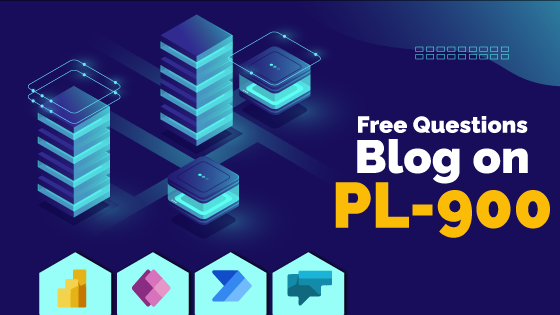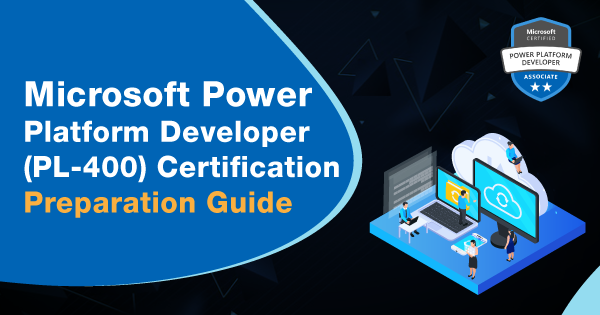In this article we have listed some of the popular PL 900 certification exam free questions for your preparation. Before going into the Power Platform Fundamentals exam questions, have a look into the basics of this certification program.
What is Power Platform Certification?
Microsoft Power Platform Certifications are in demand. PL-900 Exam is the Fundamental Power Platform Certification. This is recommended for beginners who want to start their career or understand the capabilities of the MS Power Platform.
How do I prepare for Power Platform Certification?
If you are into PL-900 exam preparation, then the below list of Power Platform Fundamentals exam questions can help you in passing out the real Microsoft Power Platform Fundamentals practice exam.
You can pass PL 900 Certification, with the help of practicing Microsoft Power Platform Certification questions which provides a detailed outline about the Microsoft Power Platform Fundamentals. By learning our Microsoft Power Platform Fundamentals practice exam, you should be able to describe the business value, core components of the platform. Also, you should be able to understand how Power BI, Power Automate, Virtual Agents, and Power App work.
Where to get PL-900 practice exam free?
These 25 PL 900 practice test free questions test your knowledge on fundamental concepts of the Microsoft Power Platform and offer you a glimpse into the real Microsoft Power Platform Fundamentals Certification (PL-900) exam questions.
The Real Microsoft Power Platform Certification cost is $99 as of Dec 2021. If you need to practice more on Microsoft PL 900 certification, you can check our PL-900 practice exam questions. Also, have a look into other Power Platform experts who found our PL 900 practice test very useful for their PL-900 exam preparation recently. Please read all the PL 900 user reviews who had tried our practice questions.
Microsoft Power Platform Fundamentals PL-900 Exam Questions
Describe the business value of Power Platform
Q 1. Your manager asks you to create a Power Platform solution for the following operations:
salespeople input a customer order, the system sends an email with an invoice to the customer, adds an invoice to SharePoint, and posts a message to Microsoft Teams.
Which two Power Platform products will you use for this solution?
A. Power Apps
B. Power Automate
C. Power BI
D. AI Builder
E. Power Virtual Agents
Correct Answers: A and B
Power Platform is a low-code option for creating business solutions. It includes four major products: Power Apps, Power Automate, Power BI, and Power Virtual Agents.
You need to use Power Apps to create a mobile app for salespeople. Then you add Power Automate flow to send an email to the customer, add an invoice to SharePoint, and post a message to Microsoft Teams. This flow will be triggered manually by submitting a customer order.
Option C is incorrect because the task doesn’t include any data analysis.
Option D is incorrect because the task doesn’t include any need for any AI models.
Option E is incorrect because the task doesn’t involve any need for virtual agents.
Q 2. You need to create a Data Loss Prevention policy for your organization by assigning connectors to the groups and limiting data exposure.
What is a default group for all connectors?
A. Business
B. Non-Business
C. Blocked
D. None
Correct Answer: B
Data Loss Prevention policy is designed to prevent unintentional exposure of the organization’s data.
You can create a Data Loss Prevention policy in the Power Platform admin center. By default, all connectors are in the Non-Business/Default group. You can move them into other groups depending on an organization’s needs.
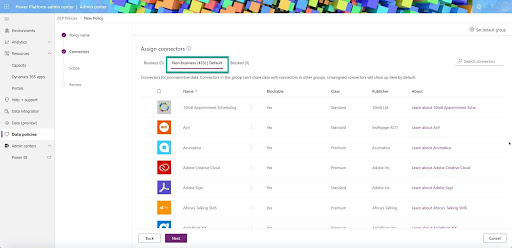
All other options are incorrect.
Q 3. What are the two types of data sources data that Power Platform connectors provide access to?
A. Azure SQL
B. Tabular data
C. Azure Table
D. Function-based data
E. Excel-based data
F. Azure Cosmos DB
Correct Answers: B and D
Power Platform connectors provide access to the two types of data sources data:
- Tabular data — a data source returns data in a structural table format, like Excel data.
- Function-based data — a data source interacts with data based on a function. It could return data in a table format, but also it can execute additional actions, like sending an email or updating a calendar. Examples of such data sources are Office 365 Users, Azure Blob Storage.
All other options are incorrect because they are not data sources data types.
Identify the core components of Power Platform
Q 4. You are trying to explain the benefits of the Dataverse (Common Data Service) business rules to your manager. He asked you about an application of the business rules to the Power Apps form.
Can a canvas app show or hide form fields based on a business rule?
A. Yes
B. No
Correct Answer: B
Dataverse provides a possibility to apply business rules to the Power Apps data and forms. Both, canvas and model-driven apps, can have business rules to set and clear form fields and validate their values. But only model-driven apps can show or hide, enable or disable form fields based on business rules. Canvas app doesn’t have these capabilities.
Q 5. You are adding an action to your Power Automate flow.
Please select an option that you can’t add in the Flow Designer as a new card action.
A. Create a new row
B. Add a new flow step
C. Send an email
D. Delete a record
E. Return value to Power Virtual Agents
Correct Answer: B
Option B is correct because the new card action doesn’t provide an “Add a new flow step” action. This is a Flow Designer’s functionality.
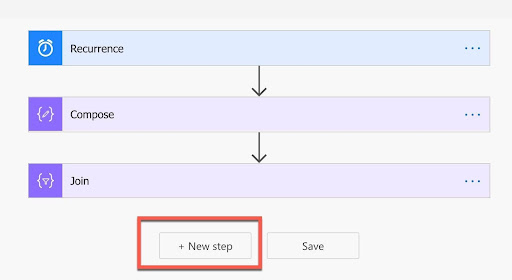
Actions are data manipulations that flow does to the data provided through the connectors. The connectors are proxy wrappers around APIs of the various applications and cloud services. Each connector has its own actions as a proxy of specific API methods.
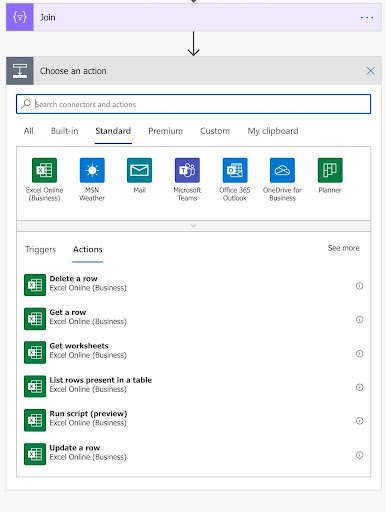
Some connectors provide actions to Create a new record, Delete a record, Send an email and Return value to Power Virtual Agents.
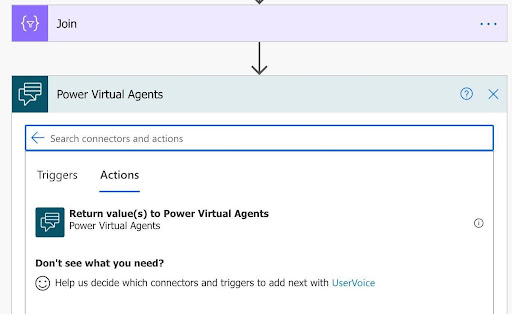
Q 6. You create a Power Platform solution in a development environment.
What type of solution will it be when you import it into a test environment?
A. Standard
B. Unmanaged
C. Test
D. Managed
E. System
Correct Answer: D
The solution is a file that can include various components, like tables, fields, apps, site maps, flows, etc.
These components are extensions or/and modifications of the Common Data Service (Dataverse) database.
Solutions can be distributed and imported into various environments. Developers can create these extensions, package them, and distribute them as solutions. There are two types of solutions: unmanaged and managed.
Unmanaged solutions are modifications that developers create in the development environment. When they are ready to test or deploy, they package and import the solution into a test or production environment. After deploying to a test or production environment, the solution becomes managed and developers cannot modify it.
The Power Platform solution supports Application lifecycle management (ALM) using Power Apps, Power Automate, and Common Data Service (Dataverse) components as a package.
All other options are incorrect.
Demonstrate the capabilities of Power BI
Q 7. You are using the Power BI Desktop application for creating a report.
What tab will you use to add data visualizations to your report?
A. Report
B. Data
C. Model
D. None
Correct Answer: A
Power BI Desktop has three tabs on the left side of the application window:
- Report tab is a canvas for creating a report.
- Data tab is a playground for the data operations.
- Model tab is to view and work with data structures and relations.
Report tab contains the Visualization panel. Users can drag and drop various data presentation controls from this panel, like line, bar, or pie charts.
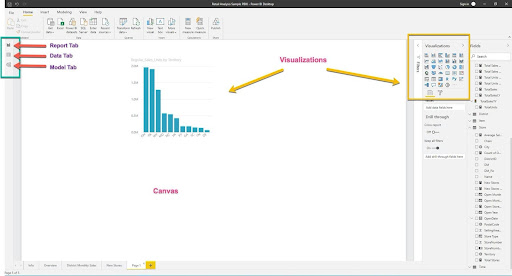
- Option B is incorrect. Data tab doesn’t contain any data visualization controls.
- Option C is incorrect. Model tab doesn’t contain any data visualization controls.
Q 8. You create a report using Power BI Desktop and need a Gantt chart visual that you don’t have on the Visualization panel.
What should you do?
A. Use Stack bar chart
B. Import from the AppSource
C. Open a report in Power BI service and add Gantt chart visual
D. Modify data to use other visual
E. Use Power Query Editor
Correct Answer: B
If you need additional Power BI visuals, you can find and add them to your environment by using AppSource or your organization visuals library. To get to the extra visuals, you need to push the “Get more visuals…” button on the Visualizations panel and select the “Get more visuals” option.
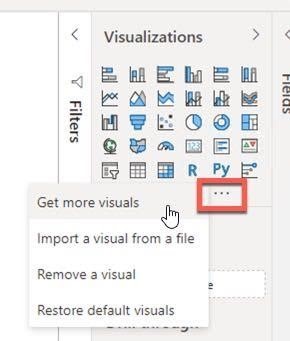
And then, search and select the visual that you need from AppSource or My Organization.
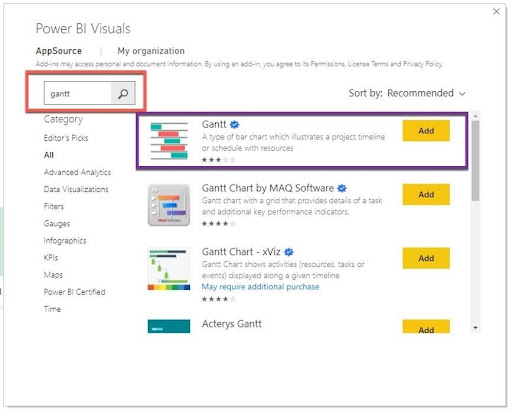
All other options are incorrect.
Q 9. You need to clean and transform data for the Power BI report.
What two applications will you use?
A. Power BI Desktop
B. Power Bi Mobile
C. Power Automate
D. Power Query Editor
E. Power BI Service
Correct Answers: A and D
Occasionally, after importing data from the different sources, you need to bring them to the same format or remove null values or change the field type. You can do the data cleaning and transformation by using Power Query Editor. It is part of the Power BI Desktop application. Both applications help users to clean and to prepare their data for analysis.
- Options B is incorrect because Power BI Mobile can work with reports and dashboards, but it doesn’t include Power Query Editor for data preparation.
- Options C is incorrect because Power Automate works with flows, and it doesn’t prepare data for Power BI analysis.
- Options E is incorrect because Power BI Service can work with reports and dashboards, but it doesn’t include Power Query Editor for data preparation.
Q 10. You create a new Power BI report.
Please select all visuals that you can use by default from the Visualization panel for your report.
A. Combo charts
B. Key influencers
C. Card
D. Flow
E. KPI
F. Bot
Correct Answers: A, B, C, and E
Power BI’s Visualization panel provides access to the various data presentation tools, like bar and column charts, combo (a combination of line and bar charts; Number 1), line, area, and pie charts. You can also find scatter plots, cards (single number [Number 2] and multi-rows), KPIs (Number 3), Key influencers (Number 4), maps, matrix, Q&A, tables, etc. You can even add a Power Apps created for Power BI (Number 5) to your report.
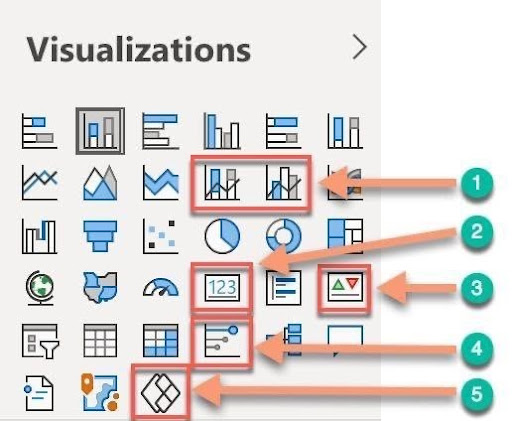
- Option D is incorrect because the Power BI Visualization panel, by default, does not provide any access to the Flow for your report.
- Option F is incorrect because the Power BI Visualization panel, by default, does not provide any access to the Bot for your report.
Q 11. Please select four types of filters that Power BI designers can use in their reports.
A. Report
B. Drilldown
C. Page
D. Dashboard
E. Visual
F. Drillthrought
Correct Answers: A, C, E, and F
Power BI designers can use four types of filters in their reports:
- Report — this type applies to all the pages in the report.
- Page — this type applies to all tiles on the current report page.
- Visual — this type applies only to a single tile.
- Drillthrough — this type allows additional details on a specific tile.
- Option B is incorrect because Power BI does not provide drill-down filters.
- Option D is incorrect because Power BI provides filters only for the reports and not for the dashboards.
Q 12. You create a new high-quality dataset in the Power BI workspace.
You want to share your work with others in your organization who can use your dataset to create their reports and dashboards by endorsing the dataset.
What are the two levels of endorsement that you can provide for your dataset?
A. High Quality
B. Promoted
C. Safe to use
D. Certified
E. Verified
F. Approved
Correct Answers: B and D
Creating a high-quality report or dashboard takes a lot of effort and time. Many developers share their high-quality work with others to save their efforts and time by endorsing their work. Endorsed dataset, report, dashboard, or app are a validation of the quality and encouragement for the safe use of these elements by others in their presentations.
There are two endorsement levels marked by tags: Promoted and Certified.
If you click on the dataset’s “More options” and select Settings, you can access the options under the Endorsement section.
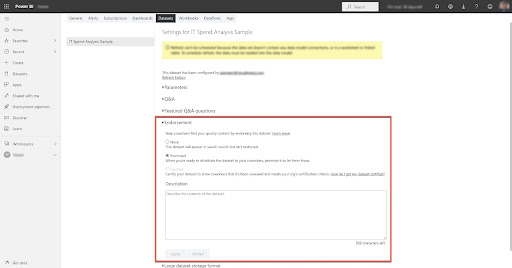
You can mark your shared dataset as Promoted. This dataset will have a blue “Promoted” tag in the Endorsement column on the Power BI portal. Any developer can set a Promoted option in Dataset settings.

If your dataset meets the organization’s quality standards, you can submit a dataset certification request according to your organization’s guidelines. After your request is granted, the dataset will have a green “Certified” tag.
All other options are incorrect.
Describe the capabilities of Power Apps
Q 13. You are editing a canvas app that contains images and text. You need to add a layout control to the new page.
What option on the Insert tab of Power Apps Studio will you choose?
A. Forms
B. Media
C. Gallery
D. Charts
E. AI Builder
Correct Answer: C
Power Apps Studio provides control sets on the Insert tab. These options include:
- Gallery — the sets of the layout controls to present data
- Forms — the set of controls for data details and work with the records
- Media — the set of controls to work with images, bar codes, video, and others
- Charts — the set of controls for the visual data presentation, like a line or pie charts
- AI Builder — the set of controls to work with cognitive services, like a business card reader or object detection
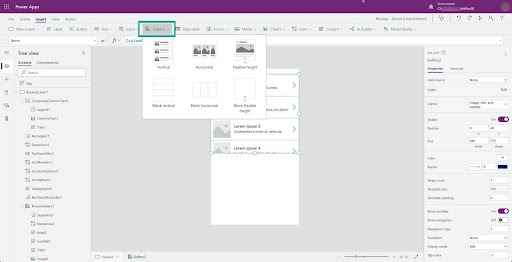
All other options are incorrect.
Q 14. You create a model-driven app and share it with your team members.
Please select two standard security roles that you can assign to the users for access to your shared app.
A. Environment Maker
B. System Administrator
C. Knowledge Manager
D. Microsoft Dataverse User
E. System Customizer
Correct Answers: B and E
When you are ready to share your Power Apps model-driven app, you can select your app and push Share on the screen’s top button bar on the Apps screen. It will open a new panel to choose the people that you want to share your application with. Because a model-driven app is based on Common Data Service (Microsoft Dataverse), you need to assign a role based access to the data. By default, the “Assign a security role” drop-down provides three roles: a Custom role of Environment Maker and two Standard roles — System Administrator and System Customizer.
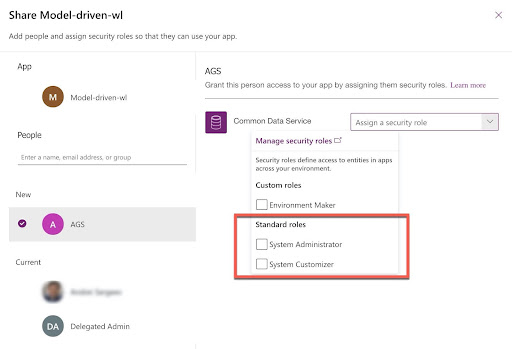
- Option A is incorrect because Environment Maker is a custom security role.
All other options are incorrect.
Q 15. You create a canvas app that uses the data in Microsoft SQL Server running in your office building.
What do you use for the data access?
A. Azure SQL Connector
B. Common data service (Dataverse)
C. Microsoft Excel
D. Data gateway
E. Microsoft Dynamics 365
Correct Answer: D
If you need to access data on-premises like Microsoft SQL Server or SharePoint, you can use connectors that utilize an on-premises gateway. Power Platform provides a Microsoft SQL Server connector that accesses a server in a cloud (MS SQL Server hosted in a cloud) or on-premises. The connector asks for information about the data gateway in case of access to an on-premises server. Before using a data gateway, you need to install it on your local network. And then, use a connector or create a gateway in the Power Apps portal and use it for data access.
All other options are incorrect.
Q 16. What are the three design phases for model-driven apps?
A. Define data sources
B. Model business data
C. Selecting connectors
D. Define business processes
E. Build the app
Correct Answers: B, D and E
When you create a model-driven app, you need to take the three-step approach:
- Model business data — prepare Common Data Service (Dataverse) data for your application. You need to determine what data you need and how the information is related.
- Define business processes — your app should help people with their business objectives. It should support and enforce consistent business processes in simple, understandable ways.
- Build the app — the last step would be easy if you do your data and business preparation work. The first two steps will help you select and implement the right components, entities, visuals, and business processes.
- Options A and C are incorrect because the model-driven app uses only one data source – Common Data Service (Dataverse).
Demonstrate the capabilities of Power Automate
Q 17. You create a Power Automate Flow and need to enter the same data several times.
What action should you select to store and reuse this data in your workflow?
A. Join
B. Compose
C. Select
D. Filter array
E. Create CSV Table
Correct Answer: B
Action Compose helps to store and reuse the data.
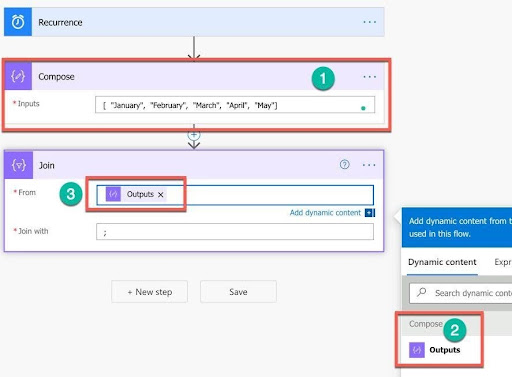
When you create a flow in Flow Designer, you select the next step and search for Data Operation Compose action. After choosing this card, you input the data that needs to be stored and reused (Number 1). You can reuse it in the next step. We are adding another Data Operation — Join. When you click on the “From” field, a pop-up screen brings you access to stored Compose data as Outputs (Number 2). If you click on Outputs, the Designer will populate the “From” field in the Join card (Number 3).
- Option A is incorrect because Join action is to delimit the input array for a provided delimiter.
- Option C is incorrect because Select action is for array members transformation.
- Option D is incorrect because Filter Array action is for array size reduction based on provided filter criteria.
- Option E is incorrect because Create CSV table action is for converting JSON array into a CSV table.
Q 18. You are developing a Power App for the sales department. They asked you to add a button to email a proposal to a client.
What type of flow will you create for this functionality?
A. Automated
B. Instant
C. Schedule
D. Desktop
E. Business Process Flow
Correct Answer: B
Power Automate provides five types of flows:
- Automated — this cloud flow type is triggered by an event, like when an email comes from your manager
- Instant — this cloud flow type is triggered manually, like when you push a button
- Schedule — this cloud flow type is triggered on a schedule, like sending a report every working data at 8 am.
- Desktop — this flow type automates processes on your desktop
- Business process flow — this flow type guides users step-by-step through the business process.
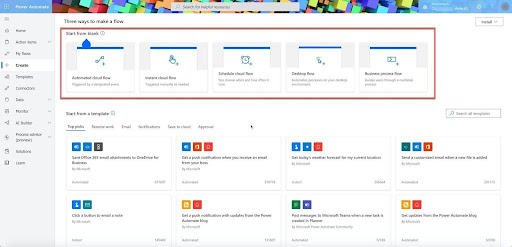
When you push the button to start an action, you will implement a manual trigger or Instant cloud flow.
All other options are incorrect.
Q 19. The maintenance department asked you to create a Power Apps app that would include a flow for the field technicians. When technicians need a part, a mobile app should guide them search and order a required part for the delivery.
What type of flow will you create for this functionality?
A. Automated
B. Instant
C. Schedule
D. Desktop
E. Business Process Flow
Correct Answer: E
Power Automate provides five types of flows:
- Automated — this cloud flow type is triggered by an event, like when an email comes from your manager
- Instant — this cloud flow type is triggered manually, like when you push a button
- Schedule — this cloud flow type is triggered on a schedule, like sending a report on every working day at 8 am.
- Desktop — this flow type automates processes on your desktop
- Business process flow — this flow type guides users step-by-step through the business process.
A mobile app should take technicians through the step-by-step process of checking if the part is in stock and order it for delivery. This type of flow is Business process flow.
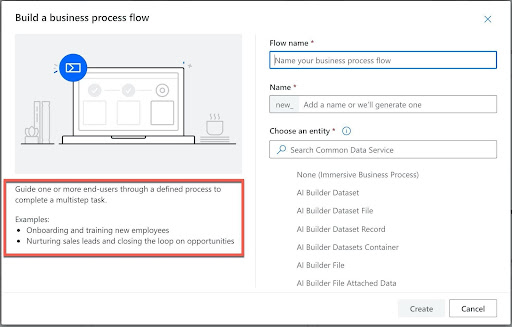
Q 20. You are creating an automated flow from the template. The flow must send an email when a new file is uploaded to the OneDrive Documents directory.
What is the next step after your trigger is in place?
A. Add Common Data Service
B. Add email trigger
C. Choose action
D. Add a condition
E. Create Business Process Flow
Correct Answer: C
Power Automate provides five types of flows:
- Automated — this cloud flow type is triggered by an event, like when an email comes from your manager.
- Instant — this cloud flow type is triggered manually, like when you push a button.
- Schedule — this cloud flow type is triggered on a schedule, like sending a report on every working day at 8 am.
- Desktop — this flow type automates processes on your desktop.
- Business process flow — this flow type guides users step-by-step through the business process.
Every Power Automate flow starts with a trigger, like an email in Inbox, and produces one or more actions, like an approval process.
Your automated flow will be triggered by the creation of a new file in the OneDrive Documents directory. After we have a trigger in place, the next step is to choose an action. The action in this flow is to send an email.
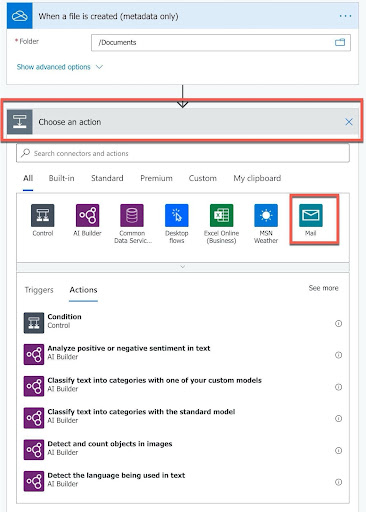
After you select Action Mail and fill in an email address, your workflow will look like this:

All other options are incorrect.
Q 21. You create a flow in a flow designer and need to insert a missing step.
What are the two options you can choose from for the new node?
A. Add a connection
B. Add an action
C. Add a compose
D. Add a parallel branch
E. Add an expression
D. Add a loop
Correct Answers: B and D
If you need to insert a new step, you can click on the arrow plus sign and choose from two option in the pop-up menu:
“Add an action” and “Add a parallel branch.”
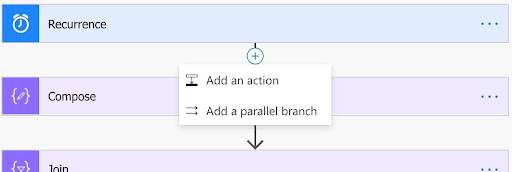
“And an actions” option opens an action dialog box that helps select an action that you want to insert.
“Add a parallel branch” option creates a new branch and opens an action dialogue in this new branch.
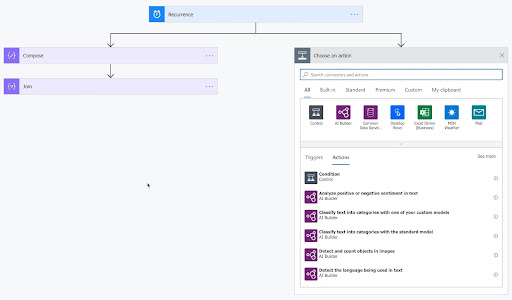
All other options represent different types and elements of actions that users can use after selecting one of the two options.
Demonstrate the business value of Power Virtual Agents
Q 22. You updated your chatbot and published it again within the Power Virtual Agents app. The bot has already been exposed to five channels. Do you need to reconnect a new version of the bot with each channel?
A. Yes
B. No
Correct Answer: B
When you publish a new version of the existing chatbot connected to several channels, you don’t need to reconnect a new version with each channel. Power Virtual Agents app will do this automatically after publishing.
Q 23. What are two topics groups automatically added when you create a chatbot using Power Virtual Agents?
A. Greeting
B. User
C. Escalate
D. System
E. Lessons
F. Thank you
Correct Answers: B and D
When you create a chatbot, Power Virtual Agents adds two topic groups: System and User. You can modify topics within these groups, but you can’t delete them.
- Options A, C, and F are incorrect. “Greeting,” “Escalate,” and “Thank you” are topics from the System group.
- Option E is incorrect. Lessons are pre-populated four lessons that are part of the User group.
Q 24. You use Power Virtual Agents Analytics to learn about which topics impact a bot’s performance the most.
Please select the names of the three analytics rate charts that should help you.
A. Engagement
B. Escalation
C. Resolution
D. Abandon
E. Total Sessions
Correct Answers: A, C, and D
The Engagement rate, Abandon rate, and Resolution rate charts provide information about which topics impact a bot’s performance the most.
Engagement is a session that starts with a trigger phrase or when it ends with escalation to the human personnel.
Abandonment is when an engagement ends without resolution or escalation after one hour elapsed.
Resolution is when an engagement ends with “Yes” or without an answer to the End of Conversation customer satisfaction survey.
The Engagement, Abandonment, and Resolution rates are the numbers of the appropriate bot sessions.
- Option B is incorrect because the Escalation rate is the number of the engaged sessions transferred to the human personnel. It provides partial information about the sessions and is already included in the Engagement rate.
- Option E is incorrect because Total Sessions is the number of the bot sessions.
Q 25. You create a simple chatbot that provides information about the store hours when users input one of the trigger phrases, like “Store hours” or “When are you open.”What three node types do you use for the bot’s conversation path?
A. Action
B. Message
C. Question
D. Trigger Phrases
E. End
F. Condition
Correct Answers: B, D, and E
Your simple chatbot provides information to the user based on the trigger phase. It includes three nodes: Trigger Phrases (Number 1), Message (Number 2), and End (Number 3). You can split your message into.
several message nodes if needed. The End (End of conversation) node could have two options: End with a survey or Transfer to an agent.
In our case, we have the End with a survey (Number 3).
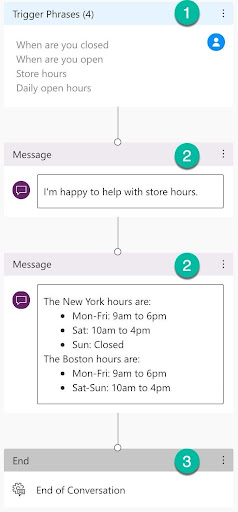
- Option A is incorrect because your bot doesn’t need any actions.
- Option C is incorrect because your bot doesn’t ask users any additional questions.
- Option E is incorrect because your bot doesn’t provide information based on a condition extracted from the user’s input.
Bottom Line
What is your understanding of the Power platform? Hope you were able to get a gist of questions you may have to attempt in the PL-900 Exam Questions. Since this is a fundamental exam, even a beginner should be able to comfortably go through it. Before taking the actual PL 900 Exam Questions, we recommend you practice more with the PL-900 Practical exam questions in a simulated exam environment.
Reference Links:
- https://docs.microsoft.com/en-us/learn/certifications/exams/pl-900
- https://docs.microsoft.com/en-us/power-automate/data-operations
- 25 Free Questions – Certificate of Cloud Security Knowledge V.4 - December 13, 2021
- 25 Free Questions on PL-900 Exam Certification - December 3, 2021
- 50 Free Terraform Certification Exam Questions - December 2, 2021
- 25 Free Questions – GCP Certified Professional Cloud Network Engineer - December 2, 2021
- 25 Free Questions – Microsoft Power BI PL-300 (DA-100) Certification - December 2, 2021
- 25 Free Questions – Google Cloud Developer Certification Exam - November 30, 2021
- 25 Free Questions – Google Cloud Certified Professional Security Engineer - November 30, 2021
- 25 Free Questions – Google Cloud Certified Professional Machine Learning Engineer - November 30, 2021

